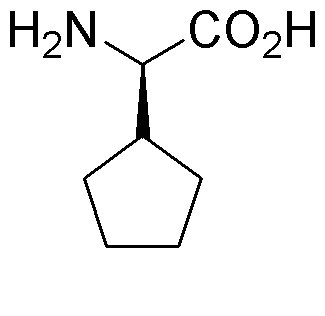D-Cyclopentylglycine is widely utilized in research focused on:
- Neuroscience Research: This compound acts as a selective antagonist for certain receptors, making it valuable in studying neurotransmission and potential treatments for neurological disorders.
- Pharmaceutical Development: Its unique structure allows for the design of novel drugs targeting specific pathways, particularly in pain management and anxiety disorders.
- Biochemical Studies: D-Cyclopentylglycine is used to investigate amino acid metabolism and its effects on cellular functions, providing insights into metabolic disorders.
- Drug Formulation: This compound can enhance the efficacy of existing medications by improving their pharmacokinetic properties, making it a key ingredient in advanced formulations.
- Research on Glycine Receptors: It serves as a tool for understanding the role of glycine in synaptic transmission, which is crucial for developing therapies for conditions like schizophrenia.
General Information
Properties
Safety and Regulations
Applications
D-Cyclopentylglycine is widely utilized in research focused on:
- Neuroscience Research: This compound acts as a selective antagonist for certain receptors, making it valuable in studying neurotransmission and potential treatments for neurological disorders.
- Pharmaceutical Development: Its unique structure allows for the design of novel drugs targeting specific pathways, particularly in pain management and anxiety disorders.
- Biochemical Studies: D-Cyclopentylglycine is used to investigate amino acid metabolism and its effects on cellular functions, providing insights into metabolic disorders.
- Drug Formulation: This compound can enhance the efficacy of existing medications by improving their pharmacokinetic properties, making it a key ingredient in advanced formulations.
- Research on Glycine Receptors: It serves as a tool for understanding the role of glycine in synaptic transmission, which is crucial for developing therapies for conditions like schizophrenia.
Documents
Safety Data Sheets (SDS)
The SDS provides comprehensive safety information on handling, storage, and disposal of the product.
Product Specification (PS)
The PS provides a comprehensive breakdown of the product’s properties, including chemical composition, physical state, purity, and storage requirements. It also details acceptable quality ranges and the product's intended applications.
Certificates of Analysis (COA)
Search for Certificates of Analysis (COA) by entering the products Lot Number. Lot and Batch Numbers can be found on a product’s label following the words ‘Lot’ or ‘Batch’.
*Catalog Number
*Lot Number
Certificates Of Origin (COO)
This COO confirms the country where the product was manufactured, and also details the materials and components used in it and whether it is derived from natural, synthetic, or other specific sources. This certificate may be required for customs, trade, and regulatory compliance.
*Catalog Number
*Lot Number
Safety Data Sheets (SDS)
The SDS provides comprehensive safety information on handling, storage, and disposal of the product.
DownloadProduct Specification (PS)
The PS provides a comprehensive breakdown of the product’s properties, including chemical composition, physical state, purity, and storage requirements. It also details acceptable quality ranges and the product's intended applications.
DownloadCertificates of Analysis (COA)
Search for Certificates of Analysis (COA) by entering the products Lot Number. Lot and Batch Numbers can be found on a product’s label following the words ‘Lot’ or ‘Batch’.
*Catalog Number
*Lot Number
Certificates Of Origin (COO)
This COO confirms the country where the product was manufactured, and also details the materials and components used in it and whether it is derived from natural, synthetic, or other specific sources. This certificate may be required for customs, trade, and regulatory compliance.


